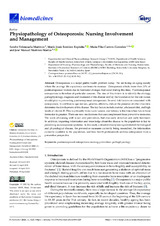Physiopathology of osteoporosis: nursing Involvement and management
Autor
Valenzuela-Martínez, Sandra
Ramírez Expósito, M.J.
Carrera González, M.P.
Martínez Martos, J.M.
Editor
MDPIFecha
2023Materia
Postmenopausal osteoporosisNursing
Prevention
Pathophysiology
METS:
Mostrar el registro METSPREMIS:
Mostrar el registro PREMISMetadatos
Mostrar el registro completo del ítemResumen
Osteoporosis is a major public health problem today. We are facing an aging society where the average life expectancy continues to increase. Osteoporosis affects more than 30% of postmenopausal women due to hormonal changes that occur during this time. Postmenopausal osteoporosis is therefore of particular concern. The aim of this review is to identify the etiology, pathophysiology, diagnosis and treatment of this disease and lay the foundation for the role nurses should play in preventing postmenopausal osteoporosis. Several risk factors are associated with osteoporosis. In addition to age and sex, genetics, ethnicity, diet, or the presence of other disorders determine the development of this disease. The key factors include exercise, a balanced diet, and high levels of vitamin D. This is primarily from a solar source, and infancy is the time when future bone formation is greatest. There are now medications that can complement these preventive measures. The work of nursing staff is not only prevention, but also early detection and early treatment. In addition, imparting information and knowledge about the disease to the population is key to preventing an osteoporosis epidemic. In this study, a detailed description is provided of the biological and physiological disease, the preventive measures currently being researched, the information currently available to the population, and how health professionals address osteoporosis from a preventive perspective.

